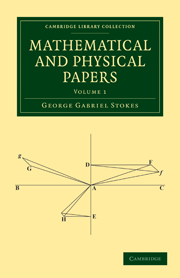Book contents
- Frontmatter
- PREFACE
- Contents
- On the Steady Motion of Incompressible Fluids
- On some cases of Fluid Motion
- On the Motion of a Piston and of the Air in a Cylinder
- On the Theories of the Internal Friction of Fluids in Motion, and of the Equilibrium and Motion of Elastic Solids
- On the Proof of the Proposition that (Mx + Ny)-1 is an Integrating Factor of the Homogeneous Differential Equation M+N dy/dx = 0
- On the Aberration of Light
- On Fresnel's Theory of the Aberration of Light
- On a Formula for determining the Optical Constants of Doubly Refracting Crystals
- On the Constitution of the Luminiferous Ether, viewed with reference to the Aberration of Light
- Report on Recent Researches on Hydrodynamics
- Supplement to a Memoir on some cases of Fluid Motion
- On the Theory of Oscillatory Waves
- On the Resistance of a Fluid to two Oscillating Spheres
- On the Critical Values of the Sums of Periodic Series
- Supplement to a paper on the Theory of Oscillatory Waves
- Index
On some cases of Fluid Motion
Published online by Cambridge University Press: 07 September 2010
- Frontmatter
- PREFACE
- Contents
- On the Steady Motion of Incompressible Fluids
- On some cases of Fluid Motion
- On the Motion of a Piston and of the Air in a Cylinder
- On the Theories of the Internal Friction of Fluids in Motion, and of the Equilibrium and Motion of Elastic Solids
- On the Proof of the Proposition that (Mx + Ny)-1 is an Integrating Factor of the Homogeneous Differential Equation M+N dy/dx = 0
- On the Aberration of Light
- On Fresnel's Theory of the Aberration of Light
- On a Formula for determining the Optical Constants of Doubly Refracting Crystals
- On the Constitution of the Luminiferous Ether, viewed with reference to the Aberration of Light
- Report on Recent Researches on Hydrodynamics
- Supplement to a Memoir on some cases of Fluid Motion
- On the Theory of Oscillatory Waves
- On the Resistance of a Fluid to two Oscillating Spheres
- On the Critical Values of the Sums of Periodic Series
- Supplement to a paper on the Theory of Oscillatory Waves
- Index
Summary
The equations of Hydrostatics are founded on the principles that the mutual action of two adjacent elements of a fluid is normal to the surface which separates them, and that the pressure is equal in all directions. The latter of these is a necessary consequence of the former, as has been shewn by Mr Airy. An exactly similar proof may be employed in Hydrodynamics, by which it may be shewn that, if the mutual action of two adjacent elements of a fluid in motion is normal to their common surface, the pressure must be equal in all directions, in order that the accelerating force which acts on the centre of gravity of an element may not become infinite, when we suppose the dimensions of the element indefinitely diminished. In Hydrostatics, the accurate agreement of the results of our calculations with experiments, (those phenomena which depend on capillary attraction being excepted), fully justifies our fundamental assumption. The same assumption is made in Hydrodynamics, and from it are deduced the fundamental equations of fluid motion. But the verification of our fundamental law in the case of a fluid at rest, does not at all prove it to be true in the case of a fluid in motion, except in the very limited case of a fluid moving as if it were solid.
- Type
- Chapter
- Information
- Mathematical and Physical Papers , pp. 17 - 68Publisher: Cambridge University PressPrint publication year: 2009First published in: 1880
- 5
- Cited by



